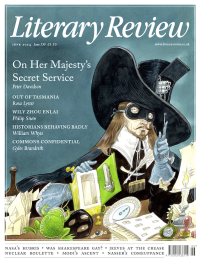Richard Dyer
Gay’s the Password
The Secret Public: How LGBTQ Resistance Shaped Popular Culture (1955–1979)
By Jon Savage
Faber & Faber 784pp £20
A boy I knew as an adolescent, five years older than me and rather intimidating, looked like James Dean, loved Elvis and dressed as a Teddy Boy. I assumed it was some kind of virile self-identification. Growing up a bit of a sissy, I took against Dean, Presley and Teds. How surprised I was when this alarming boy started to live with a series of handsome young men and play a leading role in a gay group devoted to biking and leather. Now, thanks to Jon Savage’s wonderful new book, I realise that I need not have been surprised – that there was more in common than I had suspected between my enthusiasm for Peggy Lee, Dirk Bogarde and coloured shirts and the boy’s for Dean, Presley and Teds. I found my own way to the ambiguities and vulnerabilities of Dean. Before reading Savage’s book, however, I did not know of the links between Elvis Presley and the outrageous Little Richard, subject of the book’s first chapter. Nor was I aware of the comparisons drawn between Elvis’s bumps and grinds and burlesque, such that Elvis was seen as, if not homo exactly, then not quite straight either. Even more delightful is the way Savage teases out the threads that link the Teddy Boy style to Savile Row and the splendidly regal queen Neil ‘Bunny’ Roger.
The Secret Public recounts the presence in and influence on popular culture of gay men and lesbians from the mid-1950s to the late 1970s. It is impressive not only in its scope and detail but also in its subtlety. Savage gives myriad gay composers, performers, producers, agents and hangers-on their due, but this is no queer-spotting exercise or simplistic survey of lesbian and gay expressivity. Time and again, Savage points out the importance of taste, contingency and chance. Take the twist: a dance already popular among black teenagers, it was taken up in a sleazy gay bar in New York, not least because it allowed men to dance together without touching one another, which would have been illegal. A gossip columnist noticed a celebrated aristocrat dancing there and his report led to other celebrities joining in and a dance craze taking off.
Savage’s account of the emergence of disco is even more revealing. ‘Soul Makossa’, a song by the Cameroonian musician Manu Dibango, who almost certainly was not gay, was taken up in the 1970s in the gay clubs that were burgeoning in the context of changing sexual mores and laws. Yet

Sign Up to our newsletter
Receive free articles, highlights from the archive, news, details of prizes, and much more.@Lit_Review
Follow Literary Review on Twitter
Twitter Feed
Many laptop workers will find Vincenzo Latronico’s PERFECTION sends shivers of uncomfortable recognition down their spine. I wrote about why for @Lit_Review
https://literaryreview.co.uk/hashtag-living
An insightful review by @DanielB89913888 of In Covid’s Wake (Macedo & Lee, @PrincetonUPress).
Paraphrasing: left-leaning authors critique the Covid response using right-wing arguments. A fascinating read.
via @Lit_Review
Few colours are as freighted with prejudice as pink. Because of its associations with femininity, it was long shunned by many men. Physicists denied that pink was a colour at all.
@nclarke14 follows pink’s fortunes through changing fashions.
Norma Clarke - La Vie en Rose
Norma Clarke: La Vie en Rose - Pink: The History of a Color by Michel Pastoureau (Translated from French by Jody Gladding)
literaryreview.co.uk